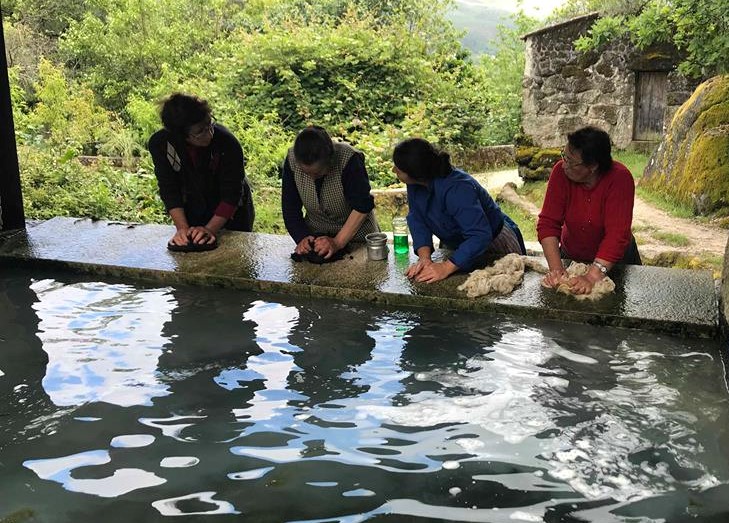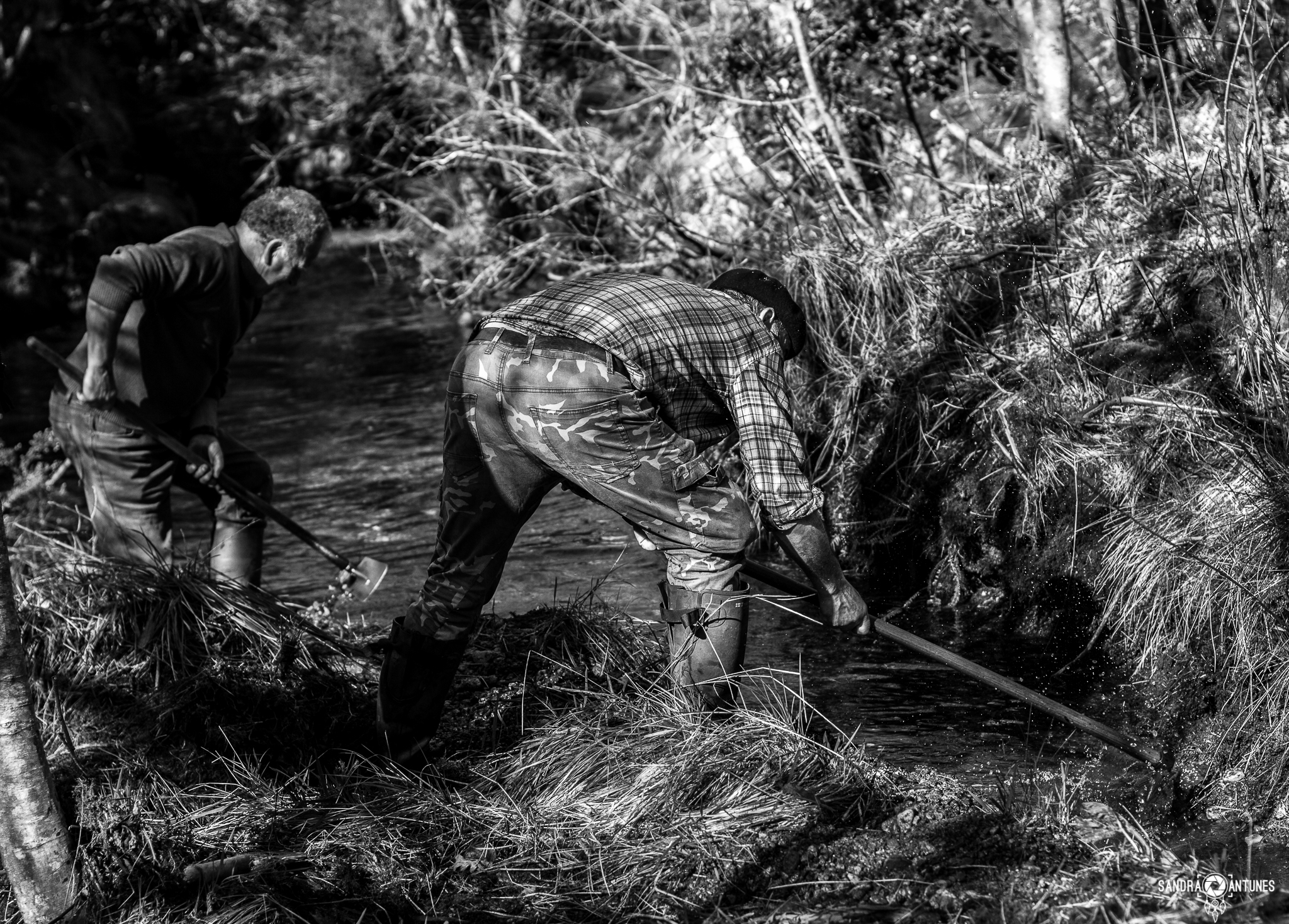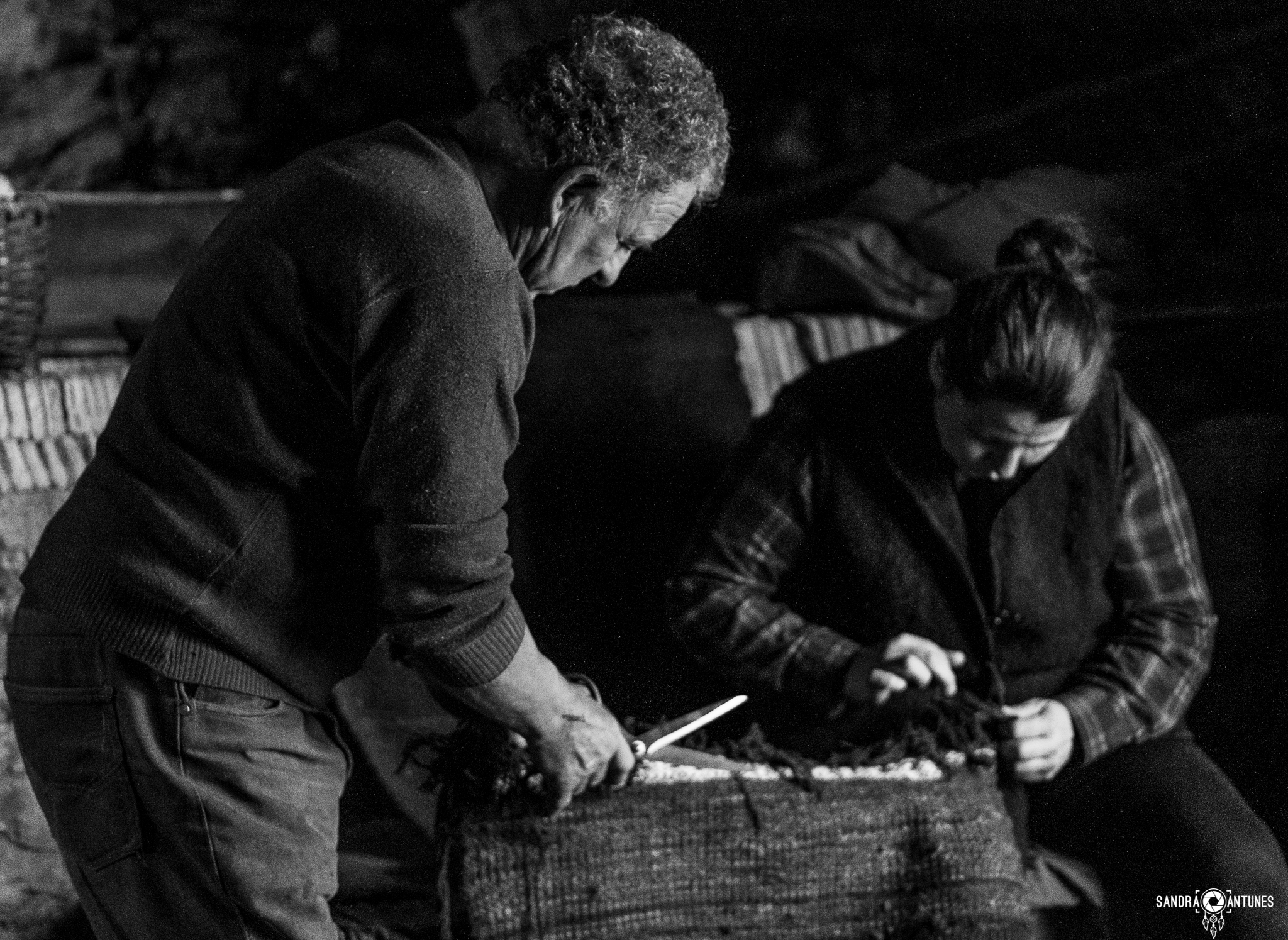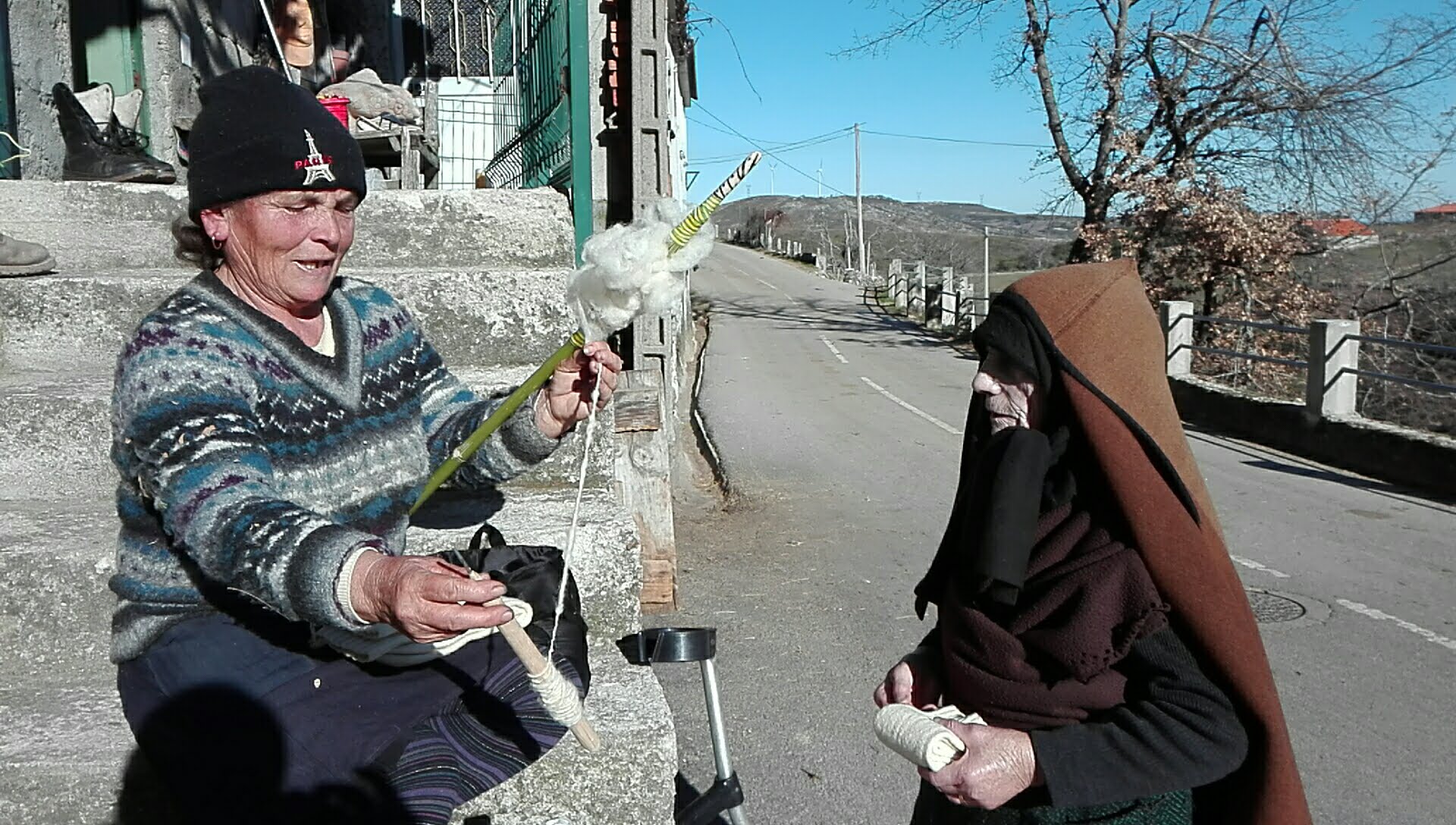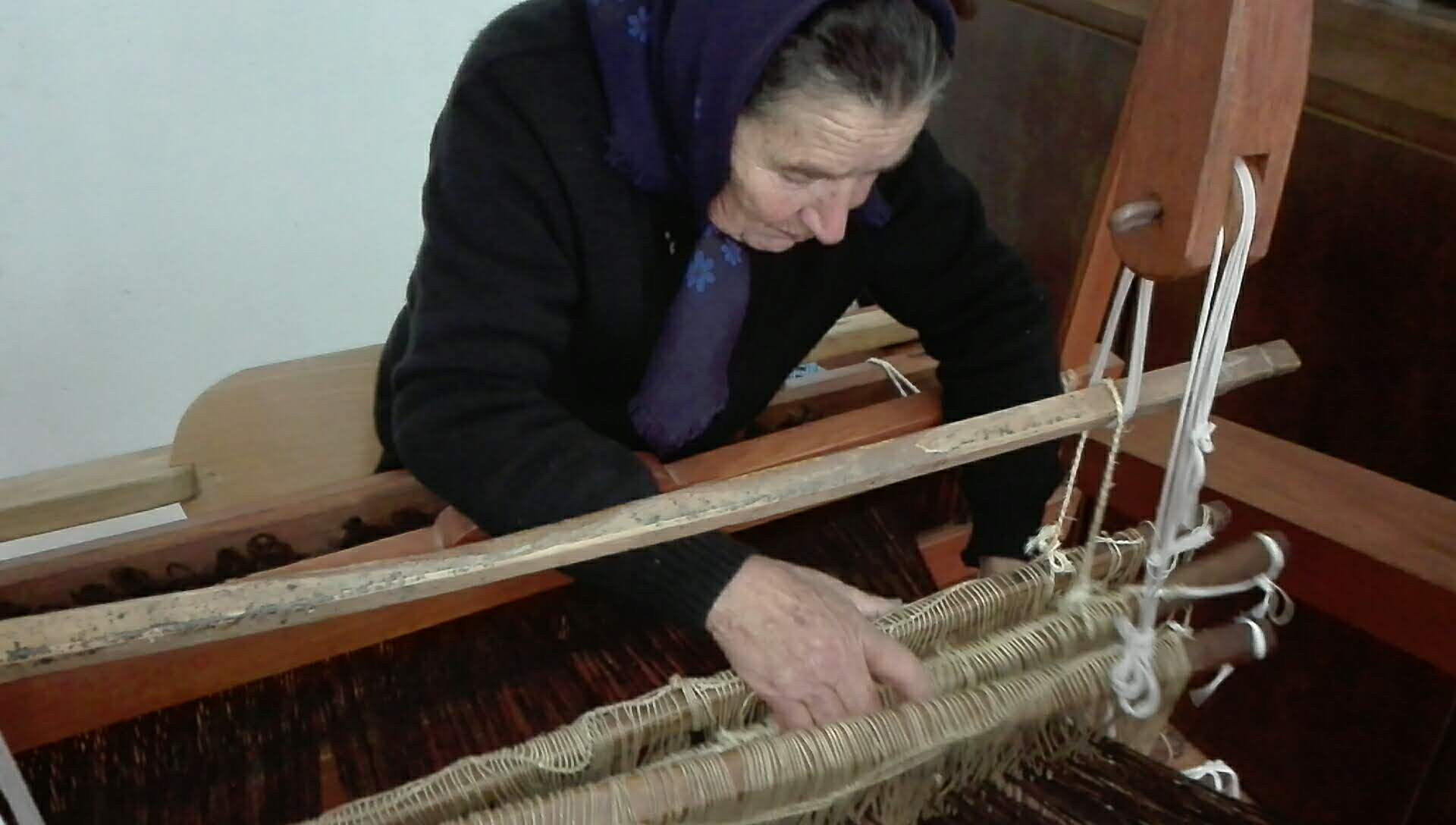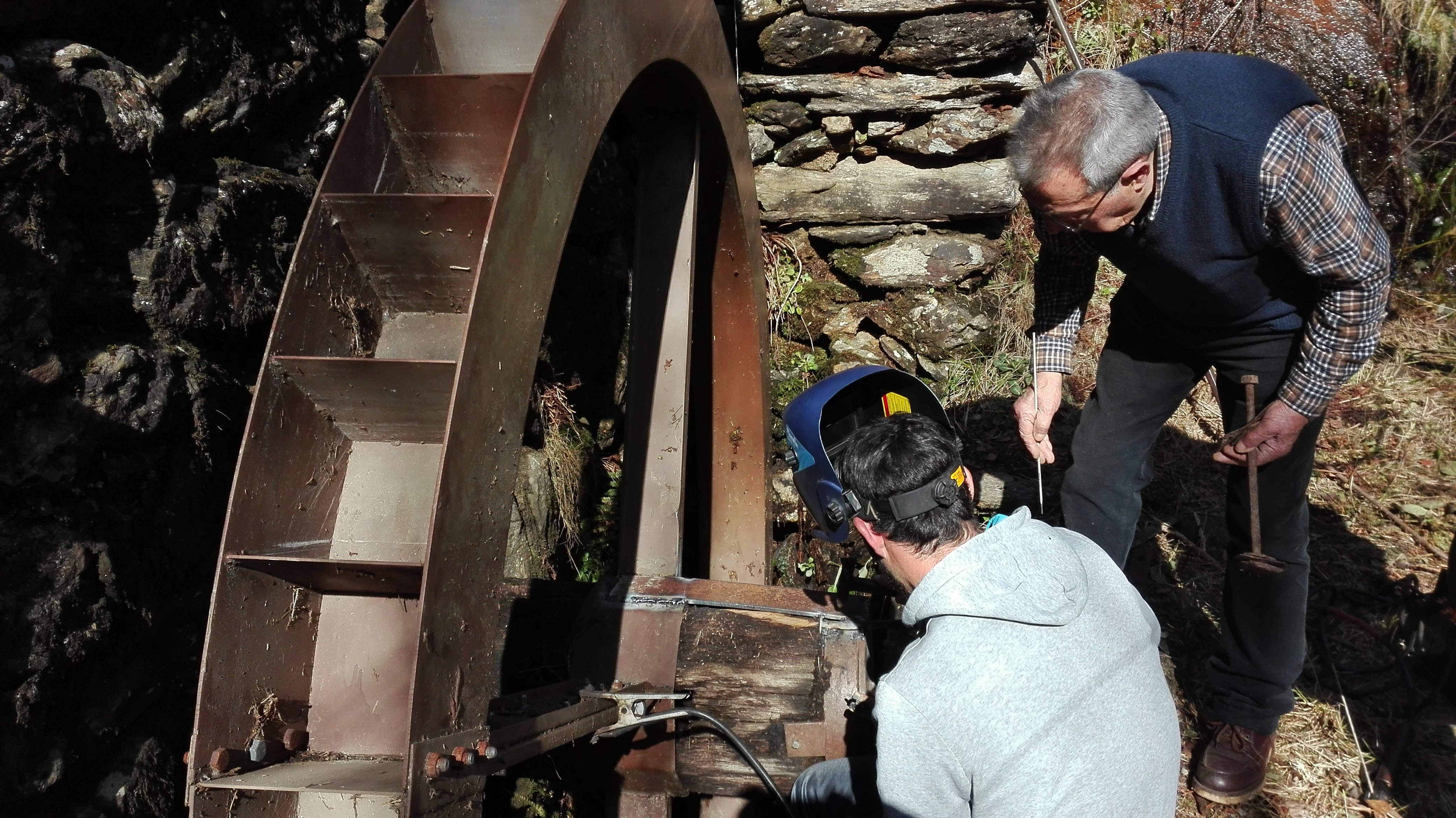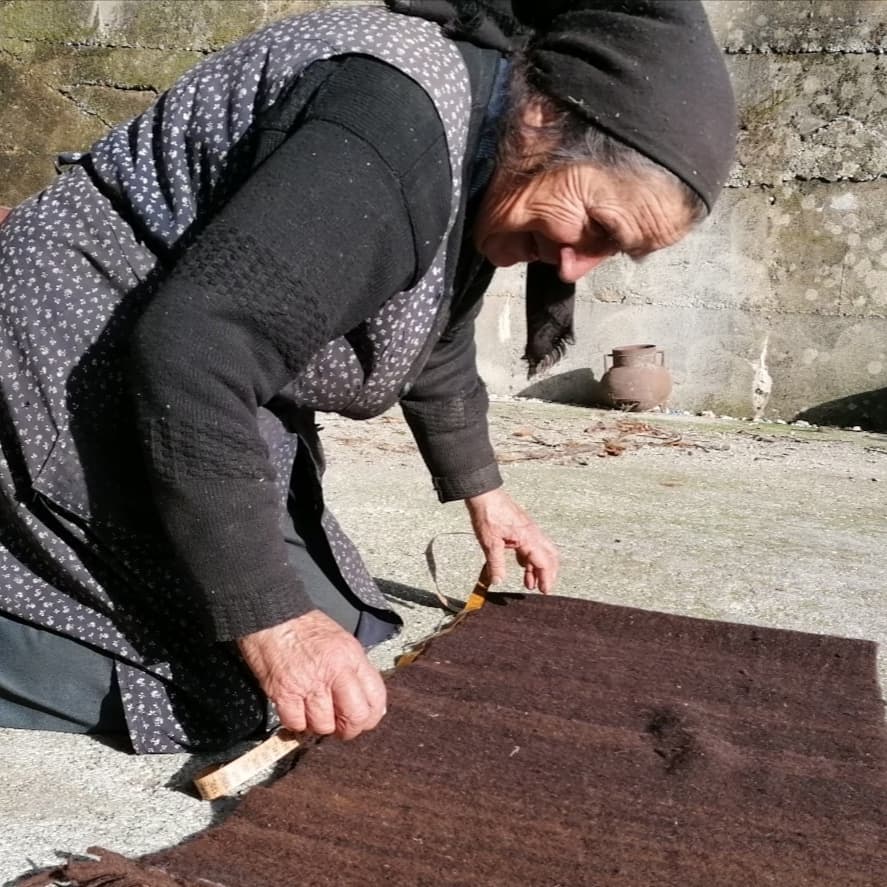Regaining a sense of belonging
The wool cycle in Barroso
Fulling mills and traditions, wool cycle in Barroso
Barroso is a mountainous territory with great natural, cultural and human values that are increasingly unprotected. For many years, the wool cycle was an agricultural practice that united communities and allowed a sustainable circular economy. Wool and burel, once so useful and necessary, fell into disuse. This project made it possible to restore practices and knowledge related to artesanal wool production processes, value local communities and enhance the identity of the territory.
EU Member State, Western Balkans or Ukraine
Portugal
Local
Cabril, Montalegre
Yes
Portugal- Norte
No
Mainly rural
It refers to other types of transformations (soft investment)
Yes
2020-11-20
No
No
No
As an individual
The general objective of this project was to collect and share all the knowledge inherent to the production of wool cycle: from the extensive grazing of local sheeps to burel capes.
The elderly, especially women, were the main target in collecting information, as they were responsible for most of the tasks linked to the wool cycle. To disseminate the knowledge collected, we defined the target groups as children, tourists, visitors and the communities in the villages where the programming cycle took place.
The specific objectives defined were: i) identify techniques and knowledge related to the artisanal transformation of wool: from fleece to burel; ii) Recreate the wool cycle in Barroso, from shearing to burel covers; iii) Create a tourist programming cycle; iv) Understand the environmental impact of the wool cycle; v) Carry out audiovisual collection for Augmented Reality.
The wool cycle contributed to a greater connection of people to their territory, their villages, their traditions and ways of life. By reproducing tradition, the cultural and artistic dynamics linked to this know-how were reestablished. The moments of conviviality and sharing of knowledge allowed us to remember life stories, childhood memories, regenerating social identity, the sense of belonging, the consolidation of the community spirit, mutual help, intergenerational relationships. The wool cycle strengthened the affective and emotional connections between people, the places they live, nature and culture. Promoted and facilitated social inclusion. It also allowed a rapprochement between rural and urban areas, the coexistence and sharing of different levels of knowledge.
This project not only addresses specific needs, but also distributed a development model that resonates beyond its original borders.
The elderly, especially women, were the main target in collecting information, as they were responsible for most of the tasks linked to the wool cycle. To disseminate the knowledge collected, we defined the target groups as children, tourists, visitors and the communities in the villages where the programming cycle took place.
The specific objectives defined were: i) identify techniques and knowledge related to the artisanal transformation of wool: from fleece to burel; ii) Recreate the wool cycle in Barroso, from shearing to burel covers; iii) Create a tourist programming cycle; iv) Understand the environmental impact of the wool cycle; v) Carry out audiovisual collection for Augmented Reality.
The wool cycle contributed to a greater connection of people to their territory, their villages, their traditions and ways of life. By reproducing tradition, the cultural and artistic dynamics linked to this know-how were reestablished. The moments of conviviality and sharing of knowledge allowed us to remember life stories, childhood memories, regenerating social identity, the sense of belonging, the consolidation of the community spirit, mutual help, intergenerational relationships. The wool cycle strengthened the affective and emotional connections between people, the places they live, nature and culture. Promoted and facilitated social inclusion. It also allowed a rapprochement between rural and urban areas, the coexistence and sharing of different levels of knowledge.
This project not only addresses specific needs, but also distributed a development model that resonates beyond its original borders.
People
sustainability
nature
culture
inclusion
Collecting and sharing know-how related to the wool cycle, from sheep management to burel covers, allowed us to understand the environmental impact of the wool cycle. Nowadays, the close relationship between man and nature is not always healthy (the Parish of Cabril has been affected by forest fires caused by human hands). But it was not always so. Our grandmothers dealt with natural resources in a respectful and harmonious way. Nature gave them what they needed to drink, eat and wear. In return, they nurtured and cared for nature and animals.
This project allowed us to realize the need to look back and restore the current lifestyle, based on some practices used by our grandmothers.
The wool cycle begins with the extensive grazing of sheep. This practice is very important for fire prevention, coordinated forest management, soil water conservation, soil regeneration, preservation of biodiversity, conservation of the landscape and natural habitats.Reestablishing the practice of grazing indigenous breeds is essential for the balance of natural ecosystems. When grazing their flocks on the mountain, humans observe the evolution and needs of ecosystems. The presence of shepherds on the mountain reduces fire risks. Free grazing allows for the regeneration of nature, the sustainable use of natural resources, the management of land and waterways, the cleaning of springs and fountains. The wool cycle requires the use of water. This use has no waste, as the water, after being used, returns to its natural path. No chemicals are used. Washing is done with natural soap.
We consider that the exemplary nature of this project is based on the resumption of agricultural techniques and practices combined with the needs to improve the quality of life of local inhabitants. The production of wool fiber is one hundred percent organic, with zero waste, allowing the regeneration of nature and the correct use of natural resources. The wool cycle is a growing creative tourism product.
This project allowed us to realize the need to look back and restore the current lifestyle, based on some practices used by our grandmothers.
The wool cycle begins with the extensive grazing of sheep. This practice is very important for fire prevention, coordinated forest management, soil water conservation, soil regeneration, preservation of biodiversity, conservation of the landscape and natural habitats.Reestablishing the practice of grazing indigenous breeds is essential for the balance of natural ecosystems. When grazing their flocks on the mountain, humans observe the evolution and needs of ecosystems. The presence of shepherds on the mountain reduces fire risks. Free grazing allows for the regeneration of nature, the sustainable use of natural resources, the management of land and waterways, the cleaning of springs and fountains. The wool cycle requires the use of water. This use has no waste, as the water, after being used, returns to its natural path. No chemicals are used. Washing is done with natural soap.
We consider that the exemplary nature of this project is based on the resumption of agricultural techniques and practices combined with the needs to improve the quality of life of local inhabitants. The production of wool fiber is one hundred percent organic, with zero waste, allowing the regeneration of nature and the correct use of natural resources. The wool cycle is a growing creative tourism product.
To achieve the objectives we set ourselves, we developed a programming cycle in different villages in the municipality of Montalegre. In the village of Fafião, we sheared Mme Joaquina's sheep who also taught us how to wash the wool. In Tourém, we brought together the local community, tourists and visitors to carve, card and spin the wool we brought from Fafião. Still in Tourém, Mme Maria do Padre and Mme Maria Paneira taught how to weave the warp. In another community initiative, this time in the village of Pitões das Júnias, with the help of Mme Maria das Dores, we assembled the warp on the loom and started weaving. After the warp was assembled, the loom was taken to the village of Mourilhe where, for 3 days, I learned how to weave twill for burel. Once the fabrics were made, it was taken to Pisão de Tabuadela where, more than two decades later, Mr. Francisco put it back into operation and transformed the wool fabric into burel fabrics. Finally, we returned to Mourilhe for Mme Maria das Dores to cut and sew the burel cover.For each of the activities I requested the support of institutions and the involvement of local communities. They are the guardians of the techniques and knowledge that we wanted to collect and share. They were the protagonists. Connecting the local population with visitors and tourists has led to unexpected results. Bringing local communities together around what is an agricultural, cultural and artistic practice of these mountain people, asking them to talk to us and teach us about these practices were moments of general joy. The willingness of some to share, the enthusiasm for learning of others, the connection between those on the outside and those on the inside gave the older people a greater enthusiasm for transmitting information. The integration of the various people in the villages, each with their own function, with their knowledge, brought collective well-being, activated social identity, gave disadvantages and an exemplary character.
Valuing natural, cultural and human heritage is the cornerstone of this project. On the mountain, no one is left behind alone.
Call everyone to share their knowledge, listen to them with attention and interest, record this shared knowledge, put it into practice, reproducing tradition, cultural and agricultural dynamics that are so often overlooked and undervalued, include everyone in this process made it possible to raise the self-esteem of communities, give new meaning to social relations in the territory, and create new affective and emotional bonds between different actors. Creating opportunities for social interaction between inhabitants, visitors and tourists, celebrating cultural diversity, promoting intergenerational coexistence, supporting the participation of the most vulnerable members of the community, allowing and facilitating everyone's participation in the activities carried out was, without a doubt, the differentiating factor.
Society remains sectorized, the elderly are increasingly separated from the remaining generations, women remain isolated in their domestic tasks, the rural world is increasingly distant from urban life. Visitors and tourists make forays into nature, but, as a general rule, they do not come into contact with people, they do not know about their stories, their culture, their traditions, their ways of life. They visit the places, but not the people who contribute and give meaning to the territory.
These activities allowed the return to community life where everyone counts, everyone has their role, their place, their importance. The wool cycle was designed for people, with people, respecting their interests, their motivations, their needs.
Providing all participants with the possibility of feeling that they are an important part, establishing a relationship of equality between people, considering the human relationship with nature is an extension of the inner self, gave this project an exemplary character.
Call everyone to share their knowledge, listen to them with attention and interest, record this shared knowledge, put it into practice, reproducing tradition, cultural and agricultural dynamics that are so often overlooked and undervalued, include everyone in this process made it possible to raise the self-esteem of communities, give new meaning to social relations in the territory, and create new affective and emotional bonds between different actors. Creating opportunities for social interaction between inhabitants, visitors and tourists, celebrating cultural diversity, promoting intergenerational coexistence, supporting the participation of the most vulnerable members of the community, allowing and facilitating everyone's participation in the activities carried out was, without a doubt, the differentiating factor.
Society remains sectorized, the elderly are increasingly separated from the remaining generations, women remain isolated in their domestic tasks, the rural world is increasingly distant from urban life. Visitors and tourists make forays into nature, but, as a general rule, they do not come into contact with people, they do not know about their stories, their culture, their traditions, their ways of life. They visit the places, but not the people who contribute and give meaning to the territory.
These activities allowed the return to community life where everyone counts, everyone has their role, their place, their importance. The wool cycle was designed for people, with people, respecting their interests, their motivations, their needs.
Providing all participants with the possibility of feeling that they are an important part, establishing a relationship of equality between people, considering the human relationship with nature is an extension of the inner self, gave this project an exemplary character.
Since its inception, this project has had the desire to involve the largest number of people: civil society, the local community, children, the elderly, political institutions, local associations, tourists and visitors…
I asked the director of the Barroso Ecomuseum for support in using some of the Barroso Ecomuseum centers. The acceptance of this proposal facilitated the collaboration with parish councils and associations that promote villages. My presence in the villages, initially as an outsider, and, over time, almost as a resident, allowed me to better understand the communities, adapting to their rhythms, needs and expectations.
The organization and promotion of programmed activities were carried out based on a participatory approach from everyone involved, respecting the agricultural calendar, daily tasks and religious events of the local community. Promoting dialogue between the different participants ensured the motivation, commitment, availability and commitment of each one, so that those who visited us could understand the different aspects of the artisanal activity relating to the wool cycle.
The relationship with the elderly in the information searched was based on a proximity approach, with several attempts, a lot of dialogue and adaptation to the elderly's rhythm of life, adjusting to their routines. It was necessary to be accepted into their homes, sit by their side and listen. Availability to listen was essential.
The Ecomuseum and Municipality of Montalegre were always involved, they were fundamental in the logistical support of the scheduled activities. LRB and CReatour were responsible for collecting scientific and audiovisual data. The local associations that promote the villages, the parish councils, the local communities wanted to be and were called to be part of the solution. Each activity was a celebration, a meeting to share knowledge and practice in which local participants were the organizers and protagonists.
I asked the director of the Barroso Ecomuseum for support in using some of the Barroso Ecomuseum centers. The acceptance of this proposal facilitated the collaboration with parish councils and associations that promote villages. My presence in the villages, initially as an outsider, and, over time, almost as a resident, allowed me to better understand the communities, adapting to their rhythms, needs and expectations.
The organization and promotion of programmed activities were carried out based on a participatory approach from everyone involved, respecting the agricultural calendar, daily tasks and religious events of the local community. Promoting dialogue between the different participants ensured the motivation, commitment, availability and commitment of each one, so that those who visited us could understand the different aspects of the artisanal activity relating to the wool cycle.
The relationship with the elderly in the information searched was based on a proximity approach, with several attempts, a lot of dialogue and adaptation to the elderly's rhythm of life, adjusting to their routines. It was necessary to be accepted into their homes, sit by their side and listen. Availability to listen was essential.
The Ecomuseum and Municipality of Montalegre were always involved, they were fundamental in the logistical support of the scheduled activities. LRB and CReatour were responsible for collecting scientific and audiovisual data. The local associations that promote the villages, the parish councils, the local communities wanted to be and were called to be part of the solution. Each activity was a celebration, a meeting to share knowledge and practice in which local participants were the organizers and protagonists.
The wool cycle in Barroso came from my idea. With the collaboration of several stakeholders, the conception of the idea was adjusted to the territorial reality and available resources. Shepherds, weavers, spinners, a fuller, village development associations, academics, a private company, the Barroso Ecomuseum, political decision-makers and the local community were all involved and contributed value to the wool cycle in Barroso.
Shepherds, weavers, spinners and fullers contributed their experience, life stories, ways of doing things and knowing that they inherited from their grandparents. The knowledge they provided allowed us to learn about techniques and tools related to the wool cycle.
Local associations and staff from the Ecomuseum centers, helped in finding creative solutions for implementing the activities, organizing the space and welcoming.
A PhD student in Geography, Scientific Research Fellow of the CREATOUR Project and a Full Professor - Director of Lab2PT-Laboratory of Landscapes, Heritage and Territory, carried out an investigation with the aim of identifying memories, stories and songs of the villagers when working wool in the Barroso Region, relating them to creative tourism and the current creative economy. There was an entrepreneur responsible for compiling information and creating interactive activities using augmented reality. He had no funding to carry out his intentions.
The parish councils provided support in publicizing the events among the local community. The City Council supported access to the Pisão building.
This process opened the local community to dialogue, to collective thinking, it encouraged them to leave their homes, to participate, to be present, to be an integral part.
The final structure of the project and its implementation was a joint effort. Everyone's participation allowed the consolidation of the community spirit, mutual help, intergenerational relationships, sharing. Without them, it wouldn't have been possible.
Shepherds, weavers, spinners and fullers contributed their experience, life stories, ways of doing things and knowing that they inherited from their grandparents. The knowledge they provided allowed us to learn about techniques and tools related to the wool cycle.
Local associations and staff from the Ecomuseum centers, helped in finding creative solutions for implementing the activities, organizing the space and welcoming.
A PhD student in Geography, Scientific Research Fellow of the CREATOUR Project and a Full Professor - Director of Lab2PT-Laboratory of Landscapes, Heritage and Territory, carried out an investigation with the aim of identifying memories, stories and songs of the villagers when working wool in the Barroso Region, relating them to creative tourism and the current creative economy. There was an entrepreneur responsible for compiling information and creating interactive activities using augmented reality. He had no funding to carry out his intentions.
The parish councils provided support in publicizing the events among the local community. The City Council supported access to the Pisão building.
This process opened the local community to dialogue, to collective thinking, it encouraged them to leave their homes, to participate, to be present, to be an integral part.
The final structure of the project and its implementation was a joint effort. Everyone's participation allowed the consolidation of the community spirit, mutual help, intergenerational relationships, sharing. Without them, it wouldn't have been possible.
The design and implementation of this project involved understanding and applying various levels of knowledge. Agriculture, livestock, metalwork, carpentry, scientific research techniques, tourism, geography, heritage, marketing, video, spinning, weaving, felting.
Throughout the various phases of this process there was crossover between the various actors. Each person contributed their value, shared their knowledge, their ideas and, together, decisions were made. By bringing together individuals from such disparate areas of knowledge, from such diverse social and cultural backgrounds, this project safeguarded differences and promoted a cooperative relationship between the various stakeholders and varied knowledge.
Tourism technicians, researchers from the University of Minho, a video director, a marketing and communications manager, shepherds, spinners, weavers, the fuller, the locksmith, the carpenter, the receptionist worked together in the programming and production of the activities carried out in the five villages. Everyone was united with a common goal, to make the wool cycle happen, from shearing to burel covers.
Individuals from rural areas and individuals from urban areas contributed their knowledge, spoke with respect and empathy, cooperated, met each other's needs, overcame obstacles and challenges to, together, design and implement the wool cycle in Barroso.
This harmonious cooperation made it possible to understand the environmental impact of the wool cycle, value this natural, cultural and human heritage, leverage its projection at a national level, create new synergies between those involved, capture the attention of other levels of knowledge, promote social inclusion, reduce the isolation of local communities, contributing to the appreciation of the territory and improving the quality of life of its residents. The experience offered to visitors opened up good prospects for the future in Barroso.
Throughout the various phases of this process there was crossover between the various actors. Each person contributed their value, shared their knowledge, their ideas and, together, decisions were made. By bringing together individuals from such disparate areas of knowledge, from such diverse social and cultural backgrounds, this project safeguarded differences and promoted a cooperative relationship between the various stakeholders and varied knowledge.
Tourism technicians, researchers from the University of Minho, a video director, a marketing and communications manager, shepherds, spinners, weavers, the fuller, the locksmith, the carpenter, the receptionist worked together in the programming and production of the activities carried out in the five villages. Everyone was united with a common goal, to make the wool cycle happen, from shearing to burel covers.
Individuals from rural areas and individuals from urban areas contributed their knowledge, spoke with respect and empathy, cooperated, met each other's needs, overcame obstacles and challenges to, together, design and implement the wool cycle in Barroso.
This harmonious cooperation made it possible to understand the environmental impact of the wool cycle, value this natural, cultural and human heritage, leverage its projection at a national level, create new synergies between those involved, capture the attention of other levels of knowledge, promote social inclusion, reduce the isolation of local communities, contributing to the appreciation of the territory and improving the quality of life of its residents. The experience offered to visitors opened up good prospects for the future in Barroso.
The wool cycle in Barroso involved people, their emotions, beliefs, habits, behaviors, knowledge and feelings. Managing and ensuring harmony between the different agents, placing everyone on the same level of importance, value and involvement was, without a doubt, innovative.
Nowadays we are witnessing a huge amount of segregation between people. The urban world has a fast pace, people live surrounded by a huge variety of stimuli, they have high levels of stress. In the rural world it is still nature that dictates the rhythms. There are several daily tasks that have to be done, work with the animals and gardening, but there is time to, calmly, do everything. In the villages of Barroso, there are few inhabitants, isolation is an integral part of rural life.
Bringing other levels of energy to the rural world, adapting these energies to the way of life of mountain people, facilitated closeness between everyone, promoted the creation of effective bonds, the establishment of trust, acceptance and mutual respect.
There was a need to find an adjustment between everyone, sometimes requiring emotional and social skills from the different participants. Throughout the project, we all changed the way we think, the way we act, the way we communicate. Finding, together, ways of doing things, respecting the times and needs of others brought positive changes to all those involved.
The innovative nature of this project was, without a doubt, the social and emotional contribution, the sharing, the encounter, the possibility of valuing such a valuable territory, whose natural, cultural and human heritage is so unprotected.
Nowadays, projects are mainly focused on their objectives, on the imperative need to obtain resources, on demonstrating results and forget about the people who are directly and/or indirectly involved. Ensuring that everyone, with their needs and rights, are the relevant part, the part that matters, makes this project unique.
Nowadays we are witnessing a huge amount of segregation between people. The urban world has a fast pace, people live surrounded by a huge variety of stimuli, they have high levels of stress. In the rural world it is still nature that dictates the rhythms. There are several daily tasks that have to be done, work with the animals and gardening, but there is time to, calmly, do everything. In the villages of Barroso, there are few inhabitants, isolation is an integral part of rural life.
Bringing other levels of energy to the rural world, adapting these energies to the way of life of mountain people, facilitated closeness between everyone, promoted the creation of effective bonds, the establishment of trust, acceptance and mutual respect.
There was a need to find an adjustment between everyone, sometimes requiring emotional and social skills from the different participants. Throughout the project, we all changed the way we think, the way we act, the way we communicate. Finding, together, ways of doing things, respecting the times and needs of others brought positive changes to all those involved.
The innovative nature of this project was, without a doubt, the social and emotional contribution, the sharing, the encounter, the possibility of valuing such a valuable territory, whose natural, cultural and human heritage is so unprotected.
Nowadays, projects are mainly focused on their objectives, on the imperative need to obtain resources, on demonstrating results and forget about the people who are directly and/or indirectly involved. Ensuring that everyone, with their needs and rights, are the relevant part, the part that matters, makes this project unique.
The methodology used in the project combined academic and scientific research with field investigation work.
In the field, the methodology used was interviews, sometimes individual, other times collective. The use of observation was very important. In the rural world, the transmission of knowledge is mainly done through demonstration. Being attentive, observing how it is done is a very effective method for learning how to handle wool. In some situations, images and videos were recorded. The approaches were adjusted to the interlocutors and their availability.
There was a need to stay in two of the villages involved: in Mourilhe to learn how to weave twill for three days and four days in Tabuadela to get the fuller working. These on-site residences allowed the establishment of close relationships, greater sharing and delivery, an excellent result in obtaining information. Still gathering knowledge in the territory, I visited two nursing homes where I had the opportunity to find out where there were weavers and spinners.
To consolidate and deepen practical knowledge, I chose to carry out bibliographical research at the National Library of Portugal and the valuable collection of Padre Fontes, the great anthropologist of the territory. I took a guided tour of the “Gallery of rural life” at the National Museum of Ethnology, whose collection illustrates the themes of agriculture, herding, traditional technologies and domestic equipment in rural society in Portugal. I consulted and studied the Barroso Ecomuseums closely, visited the collection of the local Folklore Ranch and got to know the work of women at the Casa da Lã de Bucos.
These two approaches were important for obtaining the final results. The combination of both allowed the creation of a base solid and comprehensive framework for project success.
In the field, the methodology used was interviews, sometimes individual, other times collective. The use of observation was very important. In the rural world, the transmission of knowledge is mainly done through demonstration. Being attentive, observing how it is done is a very effective method for learning how to handle wool. In some situations, images and videos were recorded. The approaches were adjusted to the interlocutors and their availability.
There was a need to stay in two of the villages involved: in Mourilhe to learn how to weave twill for three days and four days in Tabuadela to get the fuller working. These on-site residences allowed the establishment of close relationships, greater sharing and delivery, an excellent result in obtaining information. Still gathering knowledge in the territory, I visited two nursing homes where I had the opportunity to find out where there were weavers and spinners.
To consolidate and deepen practical knowledge, I chose to carry out bibliographical research at the National Library of Portugal and the valuable collection of Padre Fontes, the great anthropologist of the territory. I took a guided tour of the “Gallery of rural life” at the National Museum of Ethnology, whose collection illustrates the themes of agriculture, herding, traditional technologies and domestic equipment in rural society in Portugal. I consulted and studied the Barroso Ecomuseums closely, visited the collection of the local Folklore Ranch and got to know the work of women at the Casa da Lã de Bucos.
These two approaches were important for obtaining the final results. The combination of both allowed the creation of a base solid and comprehensive framework for project success.
The methodology used for the research, documentation and implementation of this project can be transferred or replicated to other locations, groups of beneficiaries and different contexts. This includes the research structure, data collection approach, analysis, and strategies for community engagement.
The generated workflows, project management methods, communication strategies or problem-solving approaches are also replicable.
The established cooperation models, partnerships between different organizations, academic institutions, the local community and other partners in this project can be used in other contexts, with other beneficiaries and in different locations.
This project involved adapting to a very specific cultural context. Choosing the strategy of listening, dialogue, observation, proximity, promoting equity were valuable approaches that can be implemented in other cultural and geographical contexts.
The way documentation and knowledge sharing were implemented can be transferred to other interested groups or organizations.
All of these elements can be shared, facilitating the successful replication of the project across different locations, beneficiary groups and contexts. The transferability and replicability of projects implies adaptation, adjustment, flexibility, monitoring and verification. These management techniques were used in the Wool Cycle in Barroso. This is, therefore, a project management model that can be replicated or transferred to other locations, groups of beneficiaries and contexts.
The generated workflows, project management methods, communication strategies or problem-solving approaches are also replicable.
The established cooperation models, partnerships between different organizations, academic institutions, the local community and other partners in this project can be used in other contexts, with other beneficiaries and in different locations.
This project involved adapting to a very specific cultural context. Choosing the strategy of listening, dialogue, observation, proximity, promoting equity were valuable approaches that can be implemented in other cultural and geographical contexts.
The way documentation and knowledge sharing were implemented can be transferred to other interested groups or organizations.
All of these elements can be shared, facilitating the successful replication of the project across different locations, beneficiary groups and contexts. The transferability and replicability of projects implies adaptation, adjustment, flexibility, monitoring and verification. These management techniques were used in the Wool Cycle in Barroso. This is, therefore, a project management model that can be replicated or transferred to other locations, groups of beneficiaries and contexts.
Barroso is a region in the north of Portugal made up of two municipalities: Boticas and Montalegre. In 2018 it was declared an Agricultural Heritage of Humanity by the Food and Agriculture Organization of the United Nations (FAO). Part of the municipality of Montalegre, where the wool cycle developed, is located in the only natural reserve in Portugal classified as a National Park, and is also a Gerês-Xurés Transfrontier Biosphere Reserve. With the possibility of lithium exploration in Barroso, this entire heritage is called into question. Ecosystems and biodiversity are at risk of being lost.
The man-nature relationship, since the second half of the 20th century, has been deteriorating. The rural exodus, industrialization, the mechanization of agricultural systems, the abandonment of family farming, easier access to disposable goods and immediate consumption, chemical fertilizers, emigration, among other factors, have been the great threat to life in the Earth.
The way of life of our rural ancestors shows us how to find viable models for the necessary restoration of the planet. Going back in time, giving new meaning to the past, History, Culture, Sociology, regenerating the modus Vivendi of our ancestors allows us to find a way of living in harmony with nature, with natural resources.
The world needs local solutions for global change. If everyone, in the place they occupy, takes care of their home, their garden, their village, their city, their neighbors, their family, their community, global problems will be mitigated, ecosystems will recover, warming will global economy will decrease, poverty and social exclusion will disappear, education will have quality.
Taking care of the natural, cultural and human heritage of this territory makes it possible to solve many of the social, cultural, environmental and financial problems. It is the way we found to make our contribution to a better world.
The man-nature relationship, since the second half of the 20th century, has been deteriorating. The rural exodus, industrialization, the mechanization of agricultural systems, the abandonment of family farming, easier access to disposable goods and immediate consumption, chemical fertilizers, emigration, among other factors, have been the great threat to life in the Earth.
The way of life of our rural ancestors shows us how to find viable models for the necessary restoration of the planet. Going back in time, giving new meaning to the past, History, Culture, Sociology, regenerating the modus Vivendi of our ancestors allows us to find a way of living in harmony with nature, with natural resources.
The world needs local solutions for global change. If everyone, in the place they occupy, takes care of their home, their garden, their village, their city, their neighbors, their family, their community, global problems will be mitigated, ecosystems will recover, warming will global economy will decrease, poverty and social exclusion will disappear, education will have quality.
Taking care of the natural, cultural and human heritage of this territory makes it possible to solve many of the social, cultural, environmental and financial problems. It is the way we found to make our contribution to a better world.
Throughout this project, it was necessary to be willing to change practices, improve approaches and ways of sharing knowledge. It was necessary to include change management techniques, reducing negative impacts, leveraging positive results and increasing community empowerment.
Fulling mills and Traditions, the wool cycle in Barroso identified techniques and knowledge, recreated the production cycle, from sheep management to the creation of burel covers, designed a cycle of tourist programming and also fulfilled the objective of knowing the environmental impact of production of this organic tissue.
In addition to fulfilling the objectives it proposed, this project leveraged new activities and cultural and training dynamics in the Barroso Ecomuseum network, was part of the program to combat school failure carried out by the municipality of Montalegre, was the reason for a parade ethnographic study organized by teachers and students from the Basic School and Kindergarten of Cabril, gave rise to an e-book (attached) and a documentary (attached).
In 2021, in celebration of World Monuments and Sites Day, The Ecomuseum of Barroso celebrated the date by publishing a study on the future of burel in Barroso. This study was based on the work done in the project the wool cycle in Barroso
This project has been a remarkable journey, marked by collaboration between a variety of participants. The results obtained exceeded the established goals, demonstrating not only the achievement of the project's objectives, but also the transformative impact on local communities. By celebrating these results, we also recognize the challenges overcome and the lessons learned, which will serve as a compass for future initiatives.
By reproducing tradition, the cultural and artistic dynamics linked to this know-how were regenerated, generating direct and indirect benefits for everyone, locally and globally.
Fulling mills and Traditions, the wool cycle in Barroso identified techniques and knowledge, recreated the production cycle, from sheep management to the creation of burel covers, designed a cycle of tourist programming and also fulfilled the objective of knowing the environmental impact of production of this organic tissue.
In addition to fulfilling the objectives it proposed, this project leveraged new activities and cultural and training dynamics in the Barroso Ecomuseum network, was part of the program to combat school failure carried out by the municipality of Montalegre, was the reason for a parade ethnographic study organized by teachers and students from the Basic School and Kindergarten of Cabril, gave rise to an e-book (attached) and a documentary (attached).
In 2021, in celebration of World Monuments and Sites Day, The Ecomuseum of Barroso celebrated the date by publishing a study on the future of burel in Barroso. This study was based on the work done in the project the wool cycle in Barroso
This project has been a remarkable journey, marked by collaboration between a variety of participants. The results obtained exceeded the established goals, demonstrating not only the achievement of the project's objectives, but also the transformative impact on local communities. By celebrating these results, we also recognize the challenges overcome and the lessons learned, which will serve as a compass for future initiatives.
By reproducing tradition, the cultural and artistic dynamics linked to this know-how were regenerated, generating direct and indirect benefits for everyone, locally and globally.
Both
- Downloado futuro do burel_0.pdf
Yes
Yes
Yes
Yes
Yes
Yes
Yes

